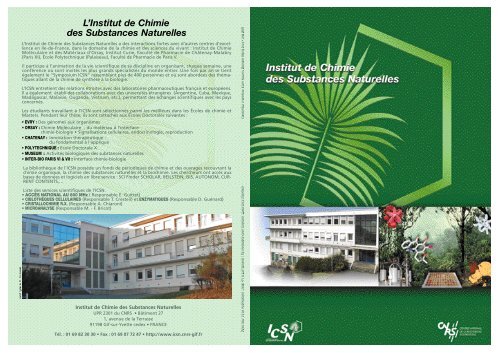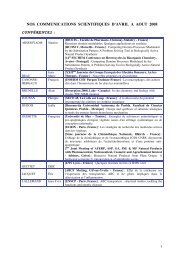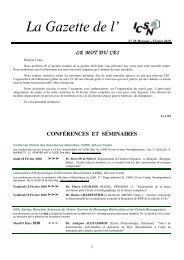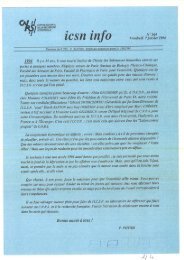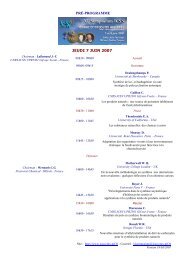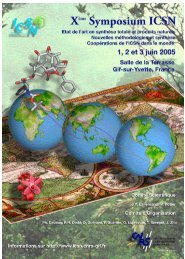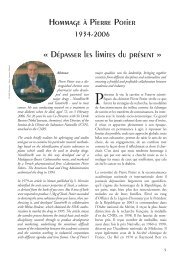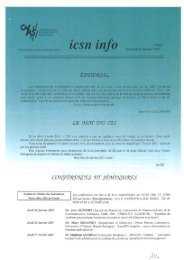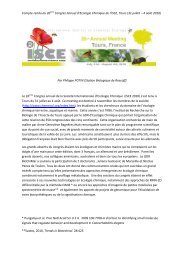L'Institut de Chimie des Substances Naturelles
L'Institut de Chimie des Substances Naturelles
L'Institut de Chimie des Substances Naturelles
- No tags were found...
You also want an ePaper? Increase the reach of your titles
YUMPU automatically turns print PDFs into web optimized ePapers that Google loves.
Le CNRS àGif-sur-YvetteThe CNRS atGif-sur-YvetteFondé en 1939, le CentreNational <strong>de</strong> la Recherc h eScientifique (CNRS) couvrel'ensemble <strong>de</strong>s domaines <strong>de</strong> lascience française.Le CNRS compte enviro n3 0 0 0 0 personnes répart i e sdans plus <strong>de</strong> 1 200 unités <strong>de</strong>re c h e rche et son budget re p r é-sente 1/4 du budget civil <strong>de</strong>re c h e rche et <strong>de</strong> développementtechnologique.Le CNRS, présent dans toutesles régions <strong>de</strong> France, possè<strong>de</strong><strong>de</strong>puis 1946 à Gif-sur- Yv e t t el'un <strong>de</strong>s plus beaux fleurons <strong>de</strong>son patrimoine : un domaine<strong>de</strong> 67 hectares dans la Va l l é e<strong>de</strong> Chevreuse où sont implantées11 unités <strong>de</strong> recherche.Foun<strong>de</strong>d in 1939, the NationalCenter for Scientific Researc h(CNRS) covers all fields ofFrench science.The CNRS employs aro u n d30.000 persons working inover 1.200 re s e a rch units witha budget re p resenting oneq u a rter of the civil budget forre s e a rch and technological<strong>de</strong>velopment.The CNRS is present in allregions of France and thel a rge Gif-sur- Yvette estatea c q u i red in 1946 is cert a i n l yone of its most beautiful sites: 67 hectares in the scenicC h e v reuse Valley surround 11different research institutes.<strong>L'Institut</strong> <strong>de</strong><strong>Chimie</strong> <strong>de</strong>s<strong>Substances</strong><strong>Naturelles</strong>The Institut <strong>de</strong><strong>Chimie</strong> <strong>de</strong>s<strong>Substances</strong><strong>Naturelles</strong>L’ICSN, l’une <strong>de</strong> ces unités, estle plus grand établissementpublic <strong>de</strong> re c h e rche en chimie<strong>de</strong> France.Pierre Potier Jean-Yves LallemandICSN - Bâtiment 27One of these re s e a rch units,the ICSN, is the largest staterunre s e a rch institute forchemistry in France.Dans ce bâtiment <strong>de</strong> 7000 m 2créé en 1959, travaillent près<strong>de</strong> 300 personnes.Nearly three hundred peoplework in this 7000 m 2 buildingconstructed in 1959.Les équipes <strong>de</strong> l'ICSN poursuivent<strong>de</strong>s re c h e rches qui se rattachentà quatre domaines :• <strong>Chimie</strong> organique <strong>de</strong>s moléculescomplexes,• P roduits naturels et chimiemédicinale,• <strong>Chimie</strong> et biologie stru c t u-rales,• <strong>Chimie</strong> et biologie <strong>de</strong> ciblesthérapeutiques.Médaille d’OrICSNInstitut <strong>de</strong> <strong>Chimie</strong> <strong>de</strong>s <strong>Substances</strong> <strong>Naturelles</strong>UPR 2301 du CNRS • Bâtiment 271, avenue <strong>de</strong> la Terrasse91198 Gif-sur-Yvette ce<strong>de</strong>x • FRANCEThe scientists at the ICSN carryout research in four differentareas :• O rganic synthesis of complexmolecules,• Natural products andmedicinal chemistry,• S t ructural chemistry andbiology,• Chemical and biologicala p p roaches to therapeutictargets.
Synthèse & MéthodologieSynthetic & Methodological approachesBeaucoup <strong>de</strong> médicaments trouvent leur origine dans la découverte <strong>de</strong> substances naturellesaux activités biologiques originales. Pour les obtenir en quantités raisonnables, ilfaut trouver <strong>de</strong> nouvelles approches synthétiques efficaces. C’est aussi le cas pour obtenir<strong>de</strong>s analogues dans le cadre général <strong>de</strong> la chimie médicinale. Le développement <strong>de</strong> lasynthèse organique est donc indispensable dans ce contexte.Il faut ainsi tout à la fois allier une recherche fondamentale en synthèse concernant lad é c o u v e rte <strong>de</strong> nouveaux procédés à <strong>de</strong>s approches originales en synthèse totale et contribuerà la production <strong>de</strong> molécules qui viennent enrichir la "chimiothèque".Ainsi plusieurs produits naturels ont fait, ou font l'objet <strong>de</strong> travaux en synthèse totale :galanthamine, taxol, manzamine A, iridal, xanthochymol, dolastatine, RP-66453...Il s’agit aussi <strong>de</strong> trouver <strong>de</strong> nouveaux outils synthétiques, c'est-à-dire <strong>de</strong> nouvellesmétho<strong>de</strong>s plus efficaces, plus douces, plus sélectives mais aussi plus respectueuses <strong>de</strong>l'environnement. Des réactions multi-composants, <strong>de</strong>s stratégies “domino” ainsi que<strong>de</strong> nouvelles méthodologies faisant appel à <strong>de</strong>s réactions catalysées par <strong>de</strong>s métaux <strong>de</strong>transition comme le titane, le palladium ou le cuivre, sont ainsi développées.Many drugs find their origin in the discovery of new natural products possessingoriginal biological activities. The structure of these molecules is generally verycomplex and, in addition, they are often produced in minute quantities, precludingextensive pharmacological studies. Analogues are also required in or<strong>de</strong>r tooptimize a target activity. This increasing need for new and complex substancesstimulates active research in organic synthesis at the ICSN.This research combines fundamental studies – new procedures as well as totalsyntheses following original pathways – with the production of an ICSN chemicallibrary. A large part of this activity is <strong>de</strong>voted to the synthesis of natural products:galanthamine, taxol, manzamine A, iridal, xanthochymol, dolastatin RP-66453...At the same time new synthetic tools are <strong>de</strong>veloped. Particular efforts are ma<strong>de</strong>to find more efficient and mil<strong>de</strong>r methods which are environmentally friendly.This, for example, involves “domino“or multicomponent transformations as wellas methodological approaches to reactions catalyzed by transition metals such astitanium, palladium or copper.IridalGalanthamineDolastatineManzamine A
<strong>Substances</strong> <strong>Naturelles</strong> & <strong>Chimie</strong> MédicinaleNatural Products & Medicinal ChemistryDeux réussites majeures <strong>de</strong> l’ICSN dans le domaine<strong>de</strong> la santé résultent d’une collaboration avec<strong>de</strong>s laboratoires pharmaceutiques (LaboratoiresPierre Fabre et Aventis).La vinorelbine (Navelbine ® ) et le docetaxel(Taxotere ® ) utilisés en chimiothérapie anticancéreuseont été synthétisés à partir <strong>de</strong> moléculesnaturelles issues respectivement <strong>de</strong> la pervenche<strong>de</strong> Madagascar (Catharanthus roseus) et <strong>de</strong> l’ifeuropéen (Taxus baccata).Justicia patentiflora collected in VietnamNegombata magnifica collected fromthe Red SeaTwo major successes at the ICSN in publichealth have been realized in collaborationwith pharmaceutical laboratories (PierreFabre Laboratories and Aventis). Vinorelbine(Navelbine ® ) and docetaxel (Taxotere ® ) aretwo anticancer drugs that have been synthesizedfrom compounds isolated from theMadagascan periwinkle (Catharanthusroseus) and the yew tree (Taxus baccata),respectively.<strong>Substances</strong> <strong>Naturelles</strong>Les matières pre m i è res (plantes, organismes marins,bactéries du sol) sont récoltées dans diff é rents pays(Nouvelle-Calédonie, Vietnam, Malaisie, Fidji,Maurice, Maroc…) riches en biodiversité. Le PôleS u b s t a n c e sN a t u relles (PSN) a pour fonction <strong>de</strong> prépa rer les extraits bruts et <strong>de</strong> les fractionner. Lesextraits et fractions purifiés vont ainsi contribuerà l’enrichissement <strong>de</strong> la collection Extractothèque.Différents criblages sur cellules ou cibles enzymatiquessont réalisés à l’ICSN ou en partenariat avec<strong>de</strong>s laboratoires publics et privés. Les fractions activessont analysées (LC/MS) et purifiées pour conduireaux composés actifs dont les stru c t u res sontd é t e rminées par diff é rentes métho<strong>de</strong>s spectro s-copiques (RX, RMN à haut champ, spectro m é t r i e<strong>de</strong> masse etc…).Antimitotic biaryls, inhibitors of tubulin assemblyCalhex 231, an antagonist of the calciumsensing receptorNatural productsRaw materials are collected from variouss o u rces in many countries (New Caledonia,Vietnam, Malaysia, Fiji, Mauritius, Moro c c o … ) .C ru<strong>de</strong> natural extracts and fractions are prepa red by the Natural Products Teams. Theseextracts and purified fractions are continuallyad<strong>de</strong>d to the natural products library.S c reening of biological activities is realized onvarious targets within the ICSN or within theframework of collaborations with public orprivate laboratories. Active fractions are furtheranalyzed (LC/MS) and purified.The stru c t u re of the active compounds is <strong>de</strong>terminedusing a variety of spectroscopic tools(X-ray diffraction, NMR, mass spectrometry).<strong>Chimie</strong> MédicinaleMedicinal ChemistryPlusieurs thèmes <strong>de</strong> re c h e rche sont développés : lessubstances hétérocycliques interagissant avec leSNC, les inhibiteurs <strong>de</strong> l’acétylcholinestérase d’originenaturelle (ex: galanthamine), les inhibiteurs<strong>de</strong>s récepteurs séro t o n i n e rgiques, les inhibiteurs dusystème tubuline - microtubules (biaryles, xanthochymol),les inhibiteurs du protéasome, les inhibiteurs<strong>de</strong> la farnésyltranférase, les antagonistes durécepteur au calcium (ex: Calhex 231), la synthèse<strong>de</strong> métabolites cytotoxiques d’origine marine et lasynthèse biomimétique, la métabolisation <strong>de</strong> moléculesd’intérêt biologique et/ou thérapeutique.Xanthochymol, inhibitor of microtubules disassemblyisolated from Garcinia spp.Diketopiperazine isolated from theMediterranean sponge Axinella vaceletiSeveral re s e a rch areas are studied: hetero c y c l i csubstances interacting with the nervous system,acetylcholinesterase inhibitors (galanthamine),inhibitors of sero t o n i n e rgic receptors, inhibitorsof the tubulin - microtubules system (biary l s ,xanthochymol), proteasome inhibitors, farn e s y ltransferase inhibitors, ligands of the calciumsensing receptor (ex : Calhex 231), synthesis ofmarine cytotoxics and biomimetic synthesis, biotransformationof bioactive molecules.Natural and Chemical LibrariesExtractothèque et ChimiothèqueDes milliers d’extraits <strong>de</strong> plantes tropicales ont étéfractionnés et répartis en plaques multipuits. Unensemble <strong>de</strong> produits chimiques d'origine nature l-le ou synthétique a été constitué à partir <strong>de</strong>s collections<strong>de</strong> molécules <strong>de</strong> chaque équipe <strong>de</strong> l'ICSN.The natural products library is constituted ofthousands of tropical plant extracts from awi<strong>de</strong> range of origins which have been fractionatedand stored in multi-well plates.A library of natural and synthetic compoundshas also been constituted from the collectionsof individual ICSN chemistry teams.Three-dimensional structure of acetylcholinesterasewith galanthamineZygogynum sp collected in New Caledonia
<strong>Chimie</strong> & Biologie StructuralesStructural Chemistry & BiologyLes nombreux travaux réalisés en chimie et biologie s'appuient sur un fort potentiel<strong>de</strong> métho<strong>de</strong>s physiques : spectrométrie <strong>de</strong> masse, résonance magnétiquen u c l é a i re (RMN), cristallographie par diffraction <strong>de</strong>s rayons X… Les équipes stru c-turées autour <strong>de</strong> ces diff é rentes techniques off rent un support extrêmement utileaux chimistes et biologistes (analyse <strong>de</strong> mécanismes, détermination <strong>de</strong> stru c t u-res…). Le niveau exceptionnel <strong>de</strong> l’équipement permet <strong>de</strong> mener <strong>de</strong>s re c h e rc h e s<strong>de</strong> pointe dans diff é rents domaines.En parallèle <strong>de</strong> développements méthodologiques spécifiques, <strong>de</strong>s re c h e rches sontmenées sur <strong>de</strong>s thèmes communs dans le domaine <strong>de</strong> la pathologie humaine.La cristallochimie permet l'étu<strong>de</strong> <strong>de</strong>s sites actifs et <strong>de</strong>s processus <strong>de</strong> catalyse <strong>de</strong>sm a c romolécules biologiques. Elle permet aussi <strong>de</strong>s travaux dans le domaine <strong>de</strong>l ' é l e c t ronique et <strong>de</strong> la photonique moléculaire ou <strong>de</strong>s cristaux liqui<strong>de</strong>s.Les applications <strong>de</strong> la spectrométrie <strong>de</strong> masse se situent principalement dans ledomaine <strong>de</strong> l'analyse <strong>de</strong> processus enzymatiques et <strong>de</strong> voies biochimiques aumoyen d'approches protéomiques. Le développement <strong>de</strong> nouveaux mo<strong>de</strong>s d'ionisationdédiés à l'analyse <strong>de</strong> protéines membranaires, ainsi que la mise au pointd ' a p p roches originales en imagerie biomédicale, prouvent leur utilité dans <strong>de</strong>stravaux concernant <strong>de</strong>s maladies génétiques, telles que la myopathie, la mucoviscidoseou la maladie <strong>de</strong> Fabry.L’axe principal <strong>de</strong> re c h e rche du Laboratoire <strong>de</strong> RMN biologique est basé surl’Imagerie et la Spectroscopie <strong>de</strong> Résonance Magnétique (IRM et SRM) in vivochez le petit animal. Les re c h e rches méthodologiques portent notamment sur lamise au point <strong>de</strong> nouveaux agents <strong>de</strong> contraste « intelligents ». Les applicationssont nombreuses : étu<strong>de</strong> <strong>de</strong> lésions cérébrales consécutives à <strong>de</strong>s pathologiesn e u rodégénératives ou aigües (ischémie, épilepsie), myopathie, insuffisance cardiaque,cancer.La re c h e rche développée en RMN à haute résolution est tournée vers l’analyse<strong>de</strong> la stru c t u re, <strong>de</strong>s interactions et <strong>de</strong> la dynamique <strong>de</strong>s macromolécules biologiques.Les projets sont sélectionnés pour leur pertinence biologique (mucoviscidose,résistance aux antibiotiques, VIH) et leurs applications potentielles. Ces étu<strong>de</strong>svont <strong>de</strong> pair avec <strong>de</strong>s travaux <strong>de</strong> modélisation moléculaire et <strong>de</strong>s développementsméthodologiques (exploitation <strong>de</strong>s couplages dipolaires résiduels, analysefine <strong>de</strong> la relaxation, RMN du soli<strong>de</strong> pour les systèmes membranaires et lesm a c romolécules micro c r i s t a l l i s é e s … ) .The numerous studies in chemistry and biology at the ICSN benefit from theavailability of state-of-the-art physical methods (mass spectrometry, nuclearmagnetic resonance (NMR), X-ray crystallography…). The research groupsinvolved in these various techniques are extremely useful to the chemists andbiochemists (mechanistic approaches, structure <strong>de</strong>termination…) allowing themto pursue innovative research in various domains.Parallel to specific methodological <strong>de</strong>velopments, collaborative research effortsare conducted in the field of human pathology.X-ray crystallography allows the study of active sites and catalytic and enzymaticprocesses in bio-macromolecules. This technique also proves very useful in thedomain of electronic and molecular photonics or liquid crystals.Applications in mass spectrometry are principally <strong>de</strong>dicated to the study of enzymaticprocesses and biological pathways by use of proteomic approaches. Thework carried out on new ionization mo<strong>de</strong>s appropriate for the analysis of membraneproteins and the <strong>de</strong>velopment of original methods in biomedical imaginghave proven their high potential for studies of such genetic diseases as myopathy,cystic fibrosis or Fabry’s disease.Research in biological NMR is mainly based on in vivo magnetic resonance spectroscopyand imaging (MRS and MRI) of small animals. Original methodologiesusing “ intelligent “ contrast agents allow a large number of applications in themedical field, ranging from the study of cerebral lesions consecutive to acute(ischemia, epilepsy) or neuro<strong>de</strong>generative pathologies, myopathy, cardiac insufficiencyand cancer.High resolution NMR research at the ICSN is mainly centered on the analysis ofthe structures, the interactions and the dynamics of biological macromolecules.Projects are selected based on their biological relevance (cystic fibrosis, antibioticresistance, HIV…) and on their potential applications. These investigationsare associated with molecular mo<strong>de</strong>ling studies and methodological <strong>de</strong>velopments(new strategies based on residual dipolar couplings, <strong>de</strong>tailed relaxationanalysis, solid state NMR for membrane systems and microcrystalline samples…).• Spectromètre <strong>de</strong> masse TOF-SIMSdédié à l’imagerie biologique• TOF-SIMS mass spectrometer forbiological imaging• Spectromètre RMN 800 MHz• 800 MHz NMR spectrometer• Modèle dérivé <strong>de</strong>s donnéesRMN <strong>de</strong> l’interaction entrela thymosine ß4 et l’actine• NMR <strong>de</strong>rived mo<strong>de</strong>l for theinteraction of thymosin ß4and actin• Suivi <strong>de</strong> migration cellulaire in vivo parIRM dans le cerveau <strong>de</strong> souris• In vivo cellular tracking by MRI in themouse brain• Imagerie par spectrométrie <strong>de</strong>masse d’un faisceau <strong>de</strong>n e u r o n e s dans le cerveau <strong>de</strong> rat• Mass spectroscopy image of aneuron bundle from a rat brain• Structure RMN d’un facteur <strong>de</strong> transcriptiond’Aspergillus nidulans et d’un complexeavec sa cible ADN• NMR structure of a transcription factor ofAspergillus nidulans and of a complex withits DNA target
Cibles Thérapeutiques : <strong>Chimie</strong> & BiologieTherapeutic Targets : Chemistry & BiologyPlusieurs enzymes capitales du métabolisme<strong>de</strong>s micro o rganismes et <strong>de</strong>s mammifères fontl’objet d’étu<strong>de</strong>s approfondies au sein <strong>de</strong>l’Institut. Qu’elles soient responsables dut r a n s p o rt <strong>de</strong> nombreuses molécules au travers<strong>de</strong> la membrane cellulaire, essentiellesau métabolisme du fer ou qu’elles contrôlentle métabolisme <strong>de</strong>s sucres ou la pro d u c t i o n<strong>de</strong> dérivés oxydés <strong>de</strong> l’azote, ces pro t é i n e sconstituent <strong>de</strong>s cibles pharmacologiques dontle contrôle permettrait d’intervenir dans <strong>de</strong>ssituations physiopathologiques aussi diff é re n-tes que la résistance aux agents anti-cancére u x ,la neuro d é g é n é rescence, l’angiogenèse tumoraleou le diabète <strong>de</strong> type 2.Dans ce <strong>de</strong>rnier cas, <strong>de</strong>s étu<strong>de</strong>s fondamentales(relation entre glycation <strong>de</strong>s protéines etdiabète) sont associées à l'élaboration <strong>de</strong>compositions pharmaceutiques cicatrisantes.L’étu<strong>de</strong> <strong>de</strong> ces cibles, abordées par <strong>de</strong>s approcheschimiques (synthèse <strong>de</strong> son<strong>de</strong>s réactionnelles,d’analogues <strong>de</strong> substrats), biochimiques(étu<strong>de</strong>s cinétiques voire structurales), ou <strong>de</strong>génomique fonctionnelle (puces à ADN ouARN interférants), permet <strong>de</strong> compre n d re leurmécanisme d’action puis d’analyser les processusassurant leur régulation. Ces analysesp e rmettent ensuite <strong>de</strong> concevoir, sur <strong>de</strong>s basesrationnelles, <strong>de</strong>s inhibiteurs spécifiques en utilisantles concepts classiques <strong>de</strong> l’inhibitionenzymatique ou les stratégies d'assemblagesur la cible.La re c h e rche <strong>de</strong> molécules capables d’interfé rer avec les protéines étudiées utilise égalementles métho<strong>de</strong>s <strong>de</strong> criblage <strong>de</strong> composésn a t u rels ou synthétiques rassemblés dans lachimiothèque <strong>de</strong> l’ICSN.Ces re c h e rches bénéficient <strong>de</strong>s services dul a b o r a t o i re <strong>de</strong> microbiologie appliquée capable<strong>de</strong> cultiver les microorganismes d’intérêtet d’assurer la purification <strong>de</strong> protéines re c o m-binantes.Ammonia (<strong>de</strong>picted as blue/grey molecules)channelling from the glutamine (bottom left)to the fructose-6P site (top right) ofglucosamine-6P synthase solved at 2 . 0 5 Å .Tryptophan 74 controls closing (in pale red) oropening (in green) of the 18Å channel.DNA chip <strong>de</strong>dicated to iron metabolismand oxido-reduction (feredox I).Red spot: over- e x p ressed gene;green spot: un<strong>de</strong>r-expressed gene;yellow spot: no regulation.Mo<strong>de</strong>l of the ATP-binding domainof Multidrug Resistance AssociatedProtein 1.Tryptophan 653 (red) is essential fornucleoti<strong>de</strong> binding.Vascularization of the chorio- allantoicmembrane of chick embryoSeveral re s e a rch projects are <strong>de</strong>dicated to thestudy of metabolic enzymes from microbial andmammalian sources. The control of these potentiallytherapeutic targets, involved for examplein the transport of various compounds thro u g hthe cell membrane, in iron metabolism, in thec o n t rol of sugar metabolism or the pro d u c t i o nof nitrogen oxi<strong>de</strong> <strong>de</strong>rivatives, may pro v i d emeans to treat physiopathological conditionssuch as resistance to anticancer drugs, neuro<strong>de</strong>generation,tumor angiogenesis and type 2diabetes. In the latter case, basic studies (relationshipbetween protein glycation and diabetes)as well as pharmaceutical applicationsare privileged.The study of the mechanism of action of thet a rget proteins is perf o rmed by chemical(mechanistic probes, substrate analogues),biochemical (kinetic and even structural studies)or functional genomic (DNA chips orsiRNA) approaches.The mechanistic knowledge thus acquire dthen permits analysis of their regulation patte rns. This information, once integrated,allows the <strong>de</strong>sign, on a rational basis, of specificinhibitors using the classical enzyme inhibitionstrategy or fragment-based, targ e t -gui<strong>de</strong>d autoassembly.The search for new compounds selectivelybinding to the proteins un<strong>de</strong>r study is alsoperformed by screening natural and syntheticcompounds collected in the Institute plantand chemical library.These projects greatly benefit from a strongcollaboration with the laboratory of appliedmicrobiology which is expert in growing the<strong>de</strong>sired microorganisms and can ensure purificationof recombinant proteins.Screening assay of cytotoxic activityA 70L fermentor in the laboratory ofapplied microbiology.Ciblothèque >Les tests biologiques mis au point par les équipes ont été robotisés, permettant le criblage <strong>de</strong> la banque <strong>de</strong>sproduits naturels ou <strong>de</strong> synthèse <strong>de</strong> l’Institut pour leur action inhibitrice ou activatrice <strong>de</strong>s protéines étudiées.Therapeutic Targets >The biological assays <strong>de</strong>signed by the ICSN research groups have been robotized to ensure efficient screening ofthe Institute natural extract collection as well as synthetic compounds for activation or inhibition properties.


